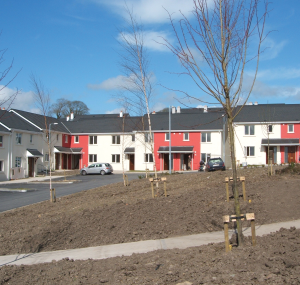Improving social housing
Cork City Council’s Director of Housing and Community Services, Valerie O’Sullivan discusses the role local government plays in social housing services.
Valerie O’Sullivan is a woman who knows a lot about social housing, having lived and worked in social housing, she is now the Director of Housing and Community Services in Cork City Council. At present Cork city has roughly 8,500 social houses. Just over 400 of these houses are classed as vacant while 282 are under repair. Approximately, 100 of these properties are vacant because they are being regenerated under the city’s Northwest Regeneration Project. This means there is a 5 per cent vacancy rate, a level O’Sullivan is very comfortable with and feels is “very good” in comparison with international standards.
However, O’Sullivan admits that Cork city has the full spectrum of social housing, both good and bad, but firmly believes her department, based in Cork’s city hall, local housing offices and works depots across the city is actively working to fix and address the bad examples and has been for many years as evidenced by mass investment in upgrading housing in the city.
Current developments
Under the Housing 2020 Programme, Cork City Council has been tasked with supplying 1,349 social houses by 2017, O’Sullivan believes they will meet that target and points to the continued investment in areas like Knocknaheeney and Spriggs Road as proof that the council are determined to tackle the social housing problem it faces.
“We’ll be in Knocknaheeney regenerating the area until 2025 at which point we will have spent over €200 million,” said O’Sullivan. “We have developed a new town centre in Knocknaheeney and when we were doing this we tried to put in things that weren’t there when the area was initially developed back in the 1970s. It now has an area housing office, an area regeneration project office, a Credit Union and a HSE presence. The area is also home to a downsizing scheme aimed at addressing the need to retain older people in this area but, at the same time, allow them to move to the small regenerated parts of the area and free up bigger homes for future need.”
O’Sullivan then turned her attention to the Spriggs Road flats, an area that she described as “in poor condition and conducive to anti-social behaviour” prior to her teams regeneration efforts. She also pointed to what is now known as the Cork Foyer as another example of the positive work of her team. The Cork Foyer used to be a convent and since its conversion it has filled a gap for young homeless people between the ages of 18-25. The Cork Foyer has, in O’Sullivan’s view, become an exemplar for other facilities in the country to directly provide in this area.
Reflecting on the lessons learned from the regeneration of these projects, O’Sullivan said “the big lesson for me from all of this was that when you improve quality, living and public realm for people you alleviate so many problems including anti-social behaviour.”
Risks
 While keen to praise the work of her department and acknowledge all they have learnt, O’Sullivan admits that policy mistakes have been made along the way. O’Sullivan believes that “social housing is about much more than building accommodation” and that as such, communities need to be built. “We have been aware of that since the introduction of the Social Housing Act in 1992 but a lot of the years since then have been spent addressing mistakes from before that time.” Previously, O’Sullivan feels that the sector and governments “pressed the panic button” leading to the building of swathes of local authority housing all over big patches of the city. “We learned to our cost that putting 100’s of people on similar incomes in an area we have covered with houses without any consideration to their access to transport, schools, community services, retail, recreation, amenities and jobs just doesn’t work. Unfortunately we have spent €100’s of millions trying to retrofit solutions for those people to those problems.”
While keen to praise the work of her department and acknowledge all they have learnt, O’Sullivan admits that policy mistakes have been made along the way. O’Sullivan believes that “social housing is about much more than building accommodation” and that as such, communities need to be built. “We have been aware of that since the introduction of the Social Housing Act in 1992 but a lot of the years since then have been spent addressing mistakes from before that time.” Previously, O’Sullivan feels that the sector and governments “pressed the panic button” leading to the building of swathes of local authority housing all over big patches of the city. “We learned to our cost that putting 100’s of people on similar incomes in an area we have covered with houses without any consideration to their access to transport, schools, community services, retail, recreation, amenities and jobs just doesn’t work. Unfortunately we have spent €100’s of millions trying to retrofit solutions for those people to those problems.”
O’Sullivan believes that in the deployment of the Housing 2020 strategy one mistake from the past has already been repeated. During the recession there was a failure to sit down with her colleagues at Departmental level and plan for current housing demands. However, O’Sullivan remains hopeful that her team can encourage city living and regenerate city life in Cork. “Collectively, we missed the preparation phase again but now we need to get beyond the ideology and get to practical solutions to make our city work for all its citizens.”
Futureproofing
With five years remaining until the end of the Housing 2020 Strategy, O’Sullivan is aware of the absence of any plan to deal with the degradation of existing housing and believes that funds will need to be invested in this area. “If the funds aren’t forthcoming we will undoubtedly pour another €200 million into another swathe of housing in the future because of the lack of crucial maintenance to these properties.”
O’Sullivan also recognises the need to improve tenant participation. She recognises it is a two-way street and feels that Approved Housing Bodies are key to the future of the management of social housing stock in the absence of additional staff resources for Housing Authorities. Knowing how important building a community is to an effective social housing environment, O’Sullivan feels local authorities need to lead by example. “We need to provide suitable communities and affordable housing, we must find ways to improve diversity, deliver equality and inclusion and improve our customer service,” O’Sullivan said.
“We need to provide our parent departments with critical feedback about what works at the coalface. Central Government’s duty is not discharged on the production of a Strategy. Ultimately, I hope Housing 2020 proves to be more than just a project title that refers to the year it reaches its conclusion. I hope it highlights the overall vision of how we want our housing sector to look. A ‘20-20’ fit is what’s needed and we still have time to ensure the strategy produces that. There is never a wrong time to do the right thing.”






